Encounters with Flamenco in Spain
BY SHEBANA COELHO
Photos by Hu Rong of Shebana Coelho and Wei Wang in Sevilla, near the studios of Calle Castellar
Note: This essay was first published in Stance on Dance’s fall/winter 2022 print issue. To learn more, visit stanceondance.com/print-publication.
I came later in life to dance, later still to flamenco. I took my first flamenco class in 2011 when I was 38.
Since then, I have started and stopped, come and gone to Spain, and done other art: theater, films. But as I began performing solo plays, the need to know flamenco in the place it was born began growing. It felt connected to deepening my body’s ability to express emotion. So in March 2022, I came to Spain on a student visa to study flamenco.
I’ve been in Spain for six months. Right now, I’m in Sevilla. There is a dizzying amount of flamenco schools here.
Everyone I know (including me) has done battle with how many classes they should/are taking: cante, choreography, technique, castanets, palmas (clapping), soniquete (rhythm and groove). And go to flamenco tablaos (small shows), espectaculos (bigger performances), or peñas (flamenco clubs).
Everyone I know is renting separate studio space to practice and paying a “bono,” a monthly packet of classes, between 10 to 40 hours or more a month. In looking for a studio, one asks: what does the floor sound like, is there a window, and in the summer – the mother of all questions – is there AC?
So much of my story of studying flamenco in Spain has been about encounters with other dancers and the stories we are telling ourselves and figuring out about why we dance: what it means, what is body? what is movement? what is feeling? what is progress? what is success? why am I here? what does flamenco mean to me? who am I when I dance? what is left of the dance after I dance? what is left of me?
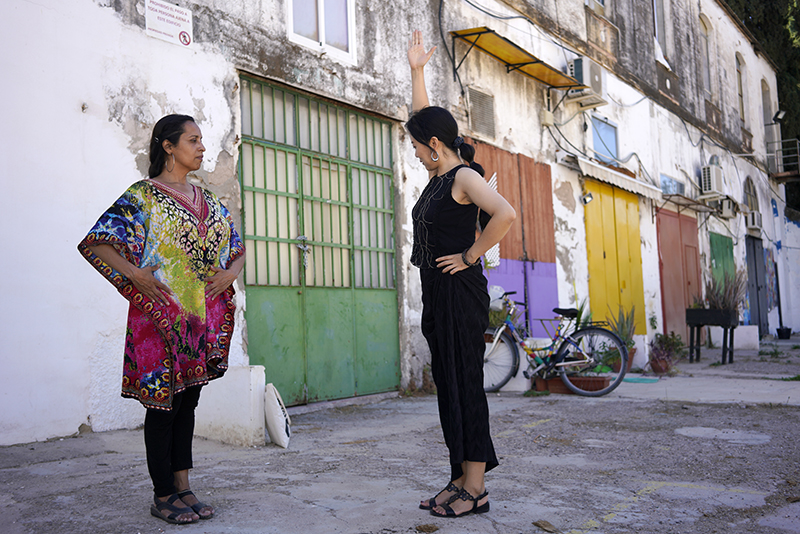
Searching for peso, gravity
~~
Flamenco is utterly recognizable and difficult to define. It is made of cante (song), baile (dance), and toque (guitar), accompanied by percussion of cajon (box drum), palmas (clapping), and castanets.
I don’t dare venture into the complexities of how flamenco was born. But what is clear is that it happened here in the south of Spain, in the province of Andalusia. A heavily cited Wikipedia entry describes it as:
an art form based on the various folkloric music traditions of southern Spain, developed within the gitano subculture of the region of Andalusia… Flamenco is closely associated to the gitanos of the Romani ethnicity… However, its style is uniquely Andalusian and flamenco artists have historically included Spaniards of both gitano and non-gitano heritage.
The gitanos, or the Spanish Roma, have played a major part in the making, dissemination, and artistry of flamenco. Their genetic origins can be traced back to India, which they left in the eleventh century and arrived in Spain in the 1400s.
Andalusia itself has lived a history of many cultures including Phoenicians, Romans, about eight centuries of Al-Andalus-Islamic Iberia, intermittent periods of slave trading, and a Catholic “Reconquista” that feels like a significant aspect of modern Andalusian culture.
Flamenco was sung and danced in houses, villages, and caves for a long time before it was recognized publicly and given the shape it has now. You can feel the potent mix of history and cultural encounters inherent in it.
I used to think of flamenco as sadness, cante jondo, the profound song of lament, but I’ve come to see it as a fullness of feeling that expresses a wide and deep spectrum of human-ness, being alive in the world.
Flamenco is made up of different styles called palos. Palo means “stick”. The major rhythms are in cycles of 4 and 12, with accented beats. To dance, you need to be able to hear the accented beats while being conscious of the encasing rhythm. And also to respond to the cante. Choreographies have steps that are a tiempo (on time), contratiempo, and syncopation.
Each palo has its own feeling – there are palos like alegrías that are happy and others like soléa or seguiriya, two of the oldest styles, that are somber, and bulerías, which is often festive and comes from the verb “to tease, to play.”
As a student, the biggest compliment you could receive when you have lost the choreography or your technique is off, when all else has failed, is that you were – al menos, at least – in compás. You kept the essence of the rhythm going.
To dance well you have to understand the song, the dance, the guitar, the palmas, because they, you, and all of this together makes flamenco flow.
Much of this may come naturally to someone who grew up here, who has had the music in their ears for years. But for many of us learning, it is a formidable task to coordinate all these elements.
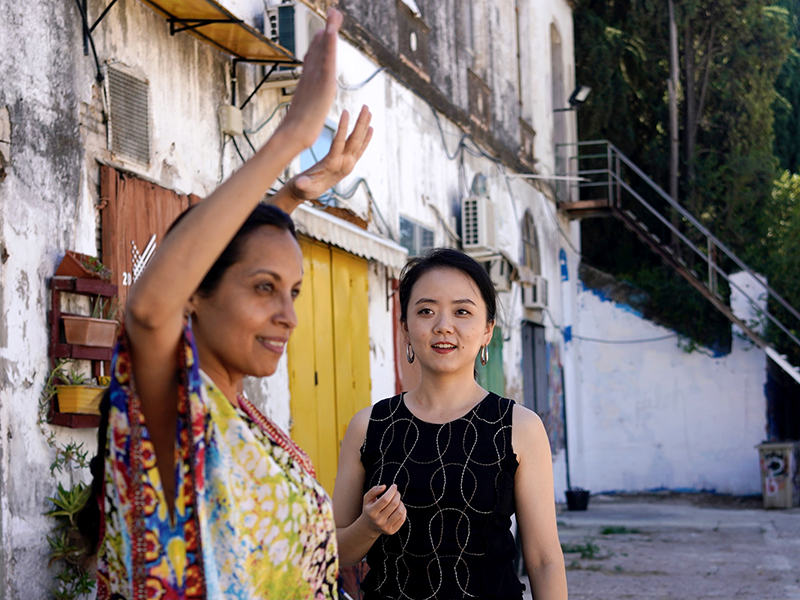
Feeling the aire of braceo, arms…
~~
Wei is 31, originally from China, went to college in the US, and has been in Seville for almost three years. I met her last summer. I remember we were at a cafe when she smiled in that sincere way of hers, and said, “Hmm, maybe your future is right here on this street.”
Turns out it was.
“Just now,” she says, “after all these years, I feel I am just learning how to study. I am learning to take just one class, spend a lot of time in the studio, really understand the steps, be gentle with my body, take time to rest.”
Much of her approach to dance and life is shaped by having scoliosis, a progressive condition that affects the curvature of the spine. When she was 18, she spent almost a year and a half in a back brace to straighten the spine. “For me,” she says, “the sense of gravity drew me to flamenco, connected to the ground, fully landing.”
“Roots,” I say.
“Yes, and that is so important to have when we are living in an information age, everyone thinking… Instead, feel the ground, feel the food. Flamenco is earth, tierra,” she says, “which, for me, means inner strength.”
Constanza and I got to talking about the cultural encounters in flamenco. She is 34, a dancer, originally from Chile. I was telling her about startling conversations I’ve had with one Spanish colleague who said that for him, the Spanish colonization of Peru was about “civilizing, not colonizing.”
“My mouth just fell open,” I said. Especially since I come from India, and my artistic work is about understanding colonization in all its forms, historical, emotional, cultural. Especially since we are in Iberia, which funded the whole enterprise of colonization. Columbus set sail from here.
She nodded. “Yes,” she said, “I’ve had similar conversations.” She is keenly conscious of the impact of Spanish colonization on her country, and on her. “Look,” she says, “I’m fair, blue-eyed and I know that just because of this, I will have a better chance of making a living in my own country. There is this hierarchy of color that favors lighter skin, and that is a legacy of colonization, that if you look like them, you have more value.”
“In India too,” I said, which was colonized by the British and the Portuguese.
“I have chosen an Indigenous middle name,” Constanza said. “I am just beginning to explore those roots. And so I do have this mixed feeling that comes up in me sometimes when learning flamenco, especially being here in Spain. I sometimes wonder…
“…what am I doing learning the dance of another culture?” we finish our sentences together…
“Yes,” I say, “I sometimes wonder too.”
“But if you learn it with the utmost respect…,” says Rhina, who is Japanese. She has been dancing flamenco for more than 20 years. Along with her husband, Javier Heredia, a flamenco festero who dances and sings in the old way, she teaches one of the most difficult palos of flamenco, bulerías. Bulerías is improvised, danced at the end of shows, informally at parties, and requires a keen sense of responding to the song and the compás. Many students I know are slightly terrified of it. For me, to see Javier sing and dance is to witness what is described as “baile natural,” a natural expression of a particular community. To see Rhina dance por bulerías is to be in awe of how attuned she is to the compás and cante.
I ask Coral de los Reyes how she feels about so many people from outside Spain learning flamenco. Coral comes from a long line of gitano flamenco singers in Jerez. I’ve known her for years because she would spend summers singing for flamenco dancers in New Mexico where I used to live. I also take cante classes with her.
“Listen,” she says, “I’m glad other people are learning it. It means the art form is alive.” What matters to her is that people are authentically themselves in it. “When you sing, you need to put a lagrima, a tear in the voice,” she says. “We sing with the viscera, the guts. There is no technique for that. You have to find it in yourself, in your way.”
Juan is finding his way. He was the lone male dancer in a technique class I took recently. He’s 38, originally from Colombia, and has been in Seville since January. Mostly, all the classes I’ve been to are majority women and I was curious how he felt, just one of him. “It doesn’t bother me,” he says. For him, “Flamenco is a way to express things I cannot express otherwise, in any other way.”
What occupies Juan most is: “Why is this dance so difficult to learn? Because there are all these cultural codes inherent in it.”
Yes. That. In the end, and also the beginning, that’s why I came to Spain: Because flamenco lives in the streets, in the body language, in the way people talk in Andalusia, how they swallow “s” and “d” (“darkness” or “oscuridad” becomes “ocuria” en Andaluz), how the tone of voice reverberates. One winter, when I was in Jerez, I swear it was raining in compás. ta ta ta ta ta ta. The streets are singing and if you listen closely, maybe you’ll hear the song.
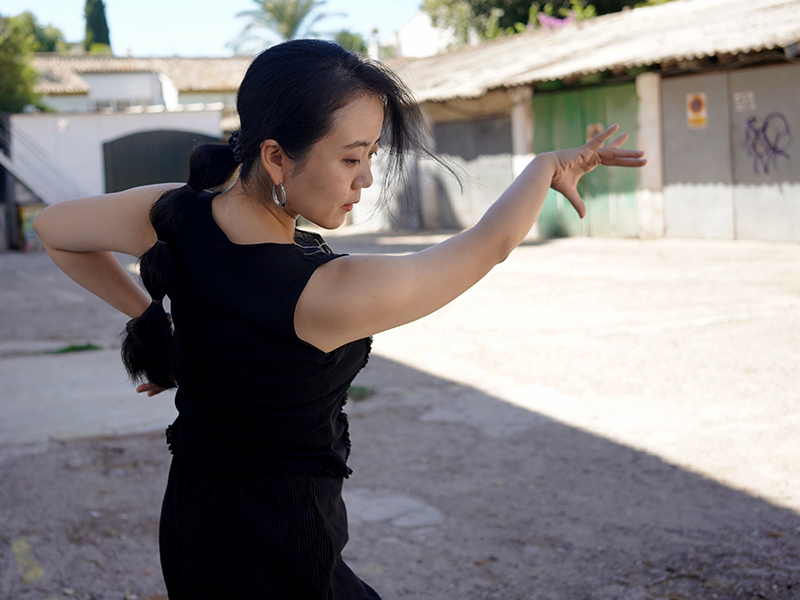
Finding the form for an escobilla, footwork
~~
I came to Spain to disappear into the dance, to apprentice myself to it. I didn’t expect to have an opportunity to bring the particularity of my art into this experience. But curiously, that has happened. I’ve been invited to present my solo play, The Good Manners of Colonized Subjects, in September at a conference at the University of Cadiz. The conference is about India and colonization, and organized by the Asociación Española de Estudios Interdisciplinarios sobre India (Spanish Association for Interdisciplinary India Studies). This happenstance is pretty wild.
My play is about the impact of European colonization on an Indian woman, about art and fear, and it is made of poetry, memoir, and dance drawn from flamenco and bharatanatyam, which I also study with Aparna Sindhoor. The play begins in India and ends in Spain. I’m using the conference invitation to do a new version with live music accompaniment by Coral de los Reyes, new choreographies developed in consultation with Jesus Fuentes and La Rhina, and a new ending that connects the shared pani (water), the words in common between Calo, the language of the Spanish Roma, and Hindi.
So now, I am rehearsing.
As I rehearse, I am thinking of the conversation with Constanza, about the legacy of colonization in a personal way. Imprinted within those who were colonized are values and beliefs that are not yours, that ennobled you if you looked, spoke, talked, and dressed like the colonizer. You believed this and generations later, this still lives in the body. Unless it is questioned, seen, and taken out, it will stay there.
For me, flamenco allows for a kind of decolonizing. I am excavating the body. Through the rigor, play, and nuance of flamenco, I am expressing emotions and movements that feel like a catharsis, and true to my way of being in the world.
~~
Recently, I asked Rhina, “When you’ve already reached such a level, what are you seeking?”
“Less,” she said. “How can I take away more and more of what is not necessary? There are dancers you look at and say, ‘They are not doing many things. But they are doing everything.’ Because I feel we learn so many steps and movements and we get greedy. We don’t want to let go of them. But I go through a process of getting rid of them just to get to the essence of how I want to communicate.”
Later, Wei told me she also asks herself “how to be me” in the dance. And that “now when I am doing the pasos, the steps” she says, “I put my own storyline into them.”
Her scoliosis condition is stable at the moment. But she lives not knowing when or if it will change. “So I am grateful for now,” she says, “and I dance for now.”
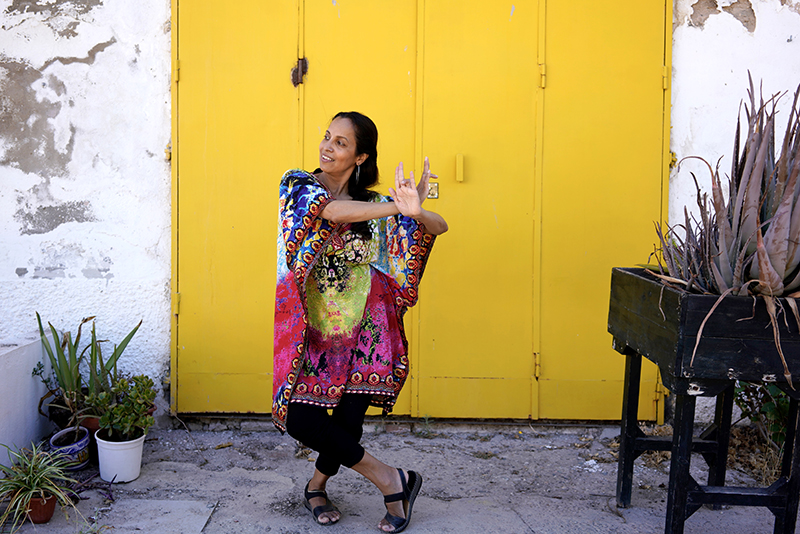
Sharing a pose from Indian classical dance
~~
I am sharing everyone’s words because inside them is a resonance that is also mine.
Dance is nature, what arises when the body seeks its own way to be known in a world that is forgetting what it means to be grounded.
Flamenco in particular brings me into the present, into presence, into feeling. I already sense I will stay in Spain longer. Everything here is calling me into the dance.
subhsé pehlé, en la oscuridad, in that first dark…
goes the first line of The Good Manners of Colonized Subjects
…the animal left the sea
found the shore
loved the dark and
“tadaap”
became
song
tree
stone
dance
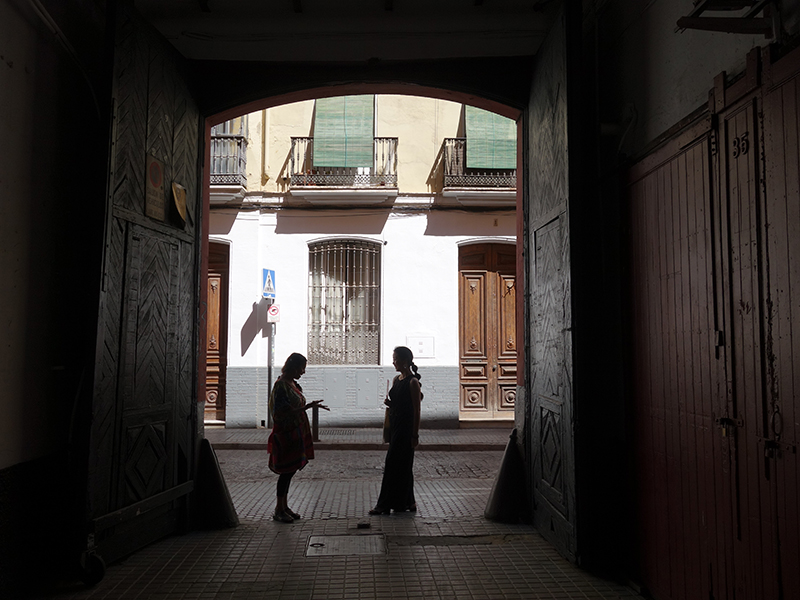
Doorway to the dance
~~
References
- Flamenco. In Wikipedia. https://en.wikipedia.org/wiki/Flamenco
- Harmon, Katherine Harmon. (2012, December 6) Genetic Sequencing Traces Gypsies Back to Ancient Indian Origin. Scientific American Blog. https://blogs.scientificamerican.com/observations/genetic-sequencing-traces-gypsies-back-to-ancient-indian-origin/
- Solsten, Eric and Sandra W. Meditz, editors. Spain: A Country Study. Washington: GPO for the Library of Congress, 1988. http://countrystudies.us/spain/1.htm
Shebana Coelho is a writer and performer, originally from India, once based in New Mexico, and now in Spain. To learn more, visit shebanacoelho.com.
Note: This essay was first published in Stance on Dance’s fall/winter 2022 print issue. To learn more, visit stanceondance.com/print-publication.
